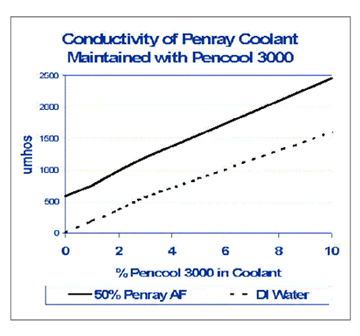01.005 Conductivity as a Tool to Evaluate Coolant Condition
Introduction:
It is has been common practice for this and other companies to promote the use of conductivity meters and conductivity measurements as a measure of the concentration of inhibitors and contaminants (total dissolved solids or TDS) in engine coolant. This coolant property is of interest because excessive TDS is generally acknowledged as negative, having been associated with premature water pump failures and/or other engine damage.
History:
The meters and procedures used for these field and laboratory evaluations are borrowed from wastewater analytical techniques. Typical concentrations of TDS in wastewater are well below 100 ppm. Concentrations of TDS in coolant have been gravimetrically measured to be in the range of well over ten thousand ppm. Further complicating the issue, the varying concentration of glycol dramatically affects the conductivity of engine coolant, even if a 10:1 aqueous dilution is prepared, per the Penray method.
In the past, a measurement by the Penray method of 2,000 µmhos has been used as a condemning limit resulting in a recommendation that the coolant be drained and replaced. Various observations have suggested weaknesses and inconsistencies with the practice of using coolant conductivity as a method of evaluating the current condition of a coolant.
Penray’s Recommendation:
Penray recommends that coolants containing any mixture of technologies from different companies not be condemned based on a conductivity reading. Research reported in an ASTM paper in November, 1997 demonstrated that the TDS concentration of mixed coolants cannot reliably be directly measured by conductivity. Indeed, coolants with high conductivities have been found, by gravimetric analysis, to contain TDS concentrations well within levels generally accepted as safe. Therefore, conductivity may prove useful only as a screening tool for some coolants and customers.
Customers exclusively using Penray inhibited antifreeze and Penray (Pencool®) SCA technology are now advised to have coolant analyzed by Penray if the conductivity exceeds 3000 mmhos. It has been possible to plot a linear relationship between the conductivity of Penray-type coolant or plain water maintained with Penray SCA technology. The plot of conductivity vs. Pencool follows:

